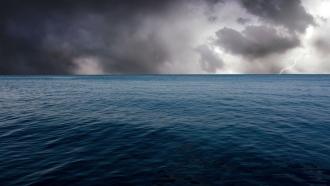
Photo: Purabi Deshpande / Research Matters
The Earth’s interior is still a mystery to us. While we have sent missions to probe the outer reaches of our Solar system, the deepest boreholes on Earth go down to only a few kilometres. The only way to learn what’s going on deep inside our planet, in the core and the mantle, is by indirect methods.
Many of us might have seen those beautiful pictures of our round, blue planet taken from space, but did you know that our planet actually looks like a bumpy potato? It has its own share of deformations, non-uniform gravity because of the unequal distribution of mass and occasionally, mountains and valleys created by the movements of tectonic plates. Considering that around three-fourths of our planet’s surface is made up of oceans, these deformities affect the shape of the oceans too. If we removed the tides and currents from the oceans on the planet, they would settle onto a smoothly undulating shape called a geoid, rising wherever there is high gravity, and sinking where gravity is low, creating what are known as “geoid anomalies”. These highs and lows are generated by uneven mass distribution within the deep Earth.
One such point of low gravity is found just south of the Indian peninsula, called the Indian Ocean Geoid Low (IOGL). The geoid low spans a vast extent south of the Indian subcontinent, and is dominated by a significant low of minus 106 metres, south of Sri Lanka.
“The existence of the Indian Ocean geoid low is one of the most outstanding problems in Earth Sciences. It is the lowest geoid/gravity anomaly on Earth and so far no consensus existed regarding its source” says Prof. Attreyee Ghosh, an Assistant Professor at the Centre for Earth Sciences, Indian Institute of Science, Bangalore. “It is remarkable as it means that there is some mass deficit in the deep mantle that's causing the low. A low gravitational potential would mean that the ocean surface itself would go down. So, for a 100 m geoid low the ocean surface would dip down by 100 m at that region”, remarks Prof. Ghosh.
In a recent study, which appeared in the journal of Geophysical Research Letters, she and her colleagues, in collaboration with researchers from the GFZ German Research Centre for Geosciences, Germany, have pondered on the reasons behind the mass deficit that is causing the geoid low. Several studies in the past have tried to explain this, most of them attributing it to a remnant of an earlier plate that dived into the Earth’s mantle beneath another plate millions of years ago. However, there has been no convincing explanation of the source -- until now.
In their study, the researchers have used numerical models of mantle convection -- a type of movement caused within a fluid where hotter and lighter material rise to the top and cooler and denser material sinks under the influence of gravity. To ‘look’ deep inside the Earth, seismic tomography models that use seismic waves to obtain a 3-dimensional picture of the Earth’s interior, were used.
The study was successful in convincingly showing that lighter material (low density anomalies) in the upper to mid mantle below the IOGL seem to be responsible for the existence of the gravity low in this region. But what causes these low density anomalies? Mantle plumes, upwellings of abnormally hot rock within the Earth's mantle, are generally thought to be the reason behind such anomalies. But in this case, no known mantle plume exists in this part of the world. To explain this, the researchers had to investigate the neighbouring regions of IOGL. Interestingly, they found that there was hot material arising from the African large low-shear-velocity province (LLSVP) or the African superplume, that was getting deflected eastward and terminating at the base of the low density region beneath the IOGL. The deflection is possibly due to the fast motion of the Indian plate.
“A geoid low or a negative geoid anomaly would be caused by a mass deficit within the deep mantle. Most of the existing theories have tried to explain this negative anomaly with the help of cold, dense oceanic plates that sank into the mantle in the past”, says Prof Ghosh. “Our study explains this low with hotter, lighter material stretching from a depth of 300 km up to ~900 km in the northern Indian Ocean, most likely stemming from the African superplume.”
This study is definitely a breakthrough in convincingly explaining the occurrence of the Indian Ocean Geoid Low using a model driven by present day density anomalies, by utilising recent models of seismic tomography. As part of future work, Prof. Ghosh and her colleagues would like to investigate the evolution of the geoid low from the past to the present using time dependent mantle convection models.






